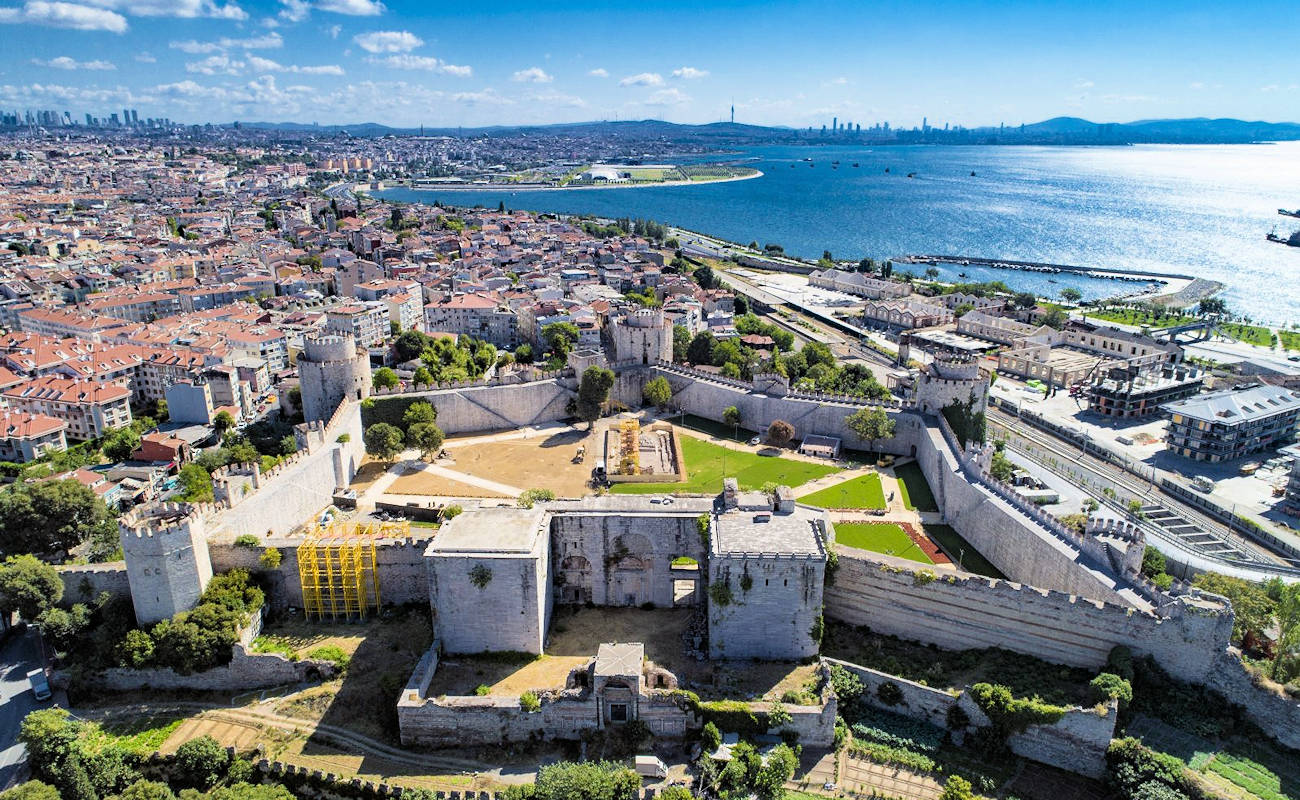
Yedikule Fortress
Yedikule Fortress, also known as Yedikule Hisarı or Yedikule Zindanları (meaning “Fortress of the Seven Towers”), is a historic fortified structure situated in the Fatih neighbourhood of Istanbul, Türkiye. The fortress is a prominent feature of the area’s architecture and played a significant role in the history of the city and the region.
Constructed in 1458 under the request of Ottoman Fatih Sultan Mehmed, the seven-tower structure was expanded with three additional towers and enveloped a segment of the old Walls of Constantinople, encompassing the two twin towers that previously served as the victorious Golden Gate created by Roman Emperors Theodosius I and Theodosius II. The fortress gained notoriety as a site of a formidable royal prison, which incarcerated notable figures throughout its history. The intrigue surrounding the fortress has captured the public’s imagination for centuries, inspiring a variety of legends, stories, and artistic depictions.
Yedikule Fortress History
After the conquest of Constantinople, the Sultan prioritized official construction projects including Yedikule and his first seraglio, Saray-i Atik. Yedikule, also known as the Fortress of Seven Towers, was constructed in the year 1457 and served as the official treasury fort of the Empire. Witnesses described the building as one of the Sultan’s palaces. Each tower of Yedikule acted as a storage for valuable goods, documents, weapons, currency, and precious metals. Technical term abbreviations in this piece have been clearly explained. The importance of fort protection was a top priority for Sultan, as it had been for his ancestors. The structure’s purpose as a fortress indicates the presence of a military outpost tasked with safeguarding the official treasury against attacks. During the sixteenth century, the treasury was relocated to the inner section of the Topkapi Palace, and the Seven Towers subsequently served as a prison for esteemed captives.
Yedikule lies on the shores of the Marmara Sea, once the main entrance gate to the city. The Byzantine city walls bequeathed the fortress with two towers and two pylons from the former Porta Aurea, the triumphal arch. Three more round towers were added to create an almost pentagonal design. The fortress divides symmetrically into two parts along an axis that runs from the midpoint of the former Porta Aurea to the central Ottoman tower. A dome-shaped structure known as the Conqueror’s Mosque features prominently in the courtyard of the fortress and is also the midpoint of its axis of symmetry.
Yedikule Fortress served as a state prison, with ambassadors from nations at war with the Ottoman Porte often incarcerated within its walls alongside political opponents and victims of palace intrigue. Among the distinguished prisoners held at Yedikule was Sultan Osman II, who was executed by Janissaries in 1622. The last Emperor of Trebizond, David Megas Komnenos, King Simon I of Kartli, and other noteworthy Ottoman pashas were also among those who met their end there. Notably, the Ottoman declaration of war on Russia was marked by the imprisonment of the entire staff of Russian ambassador Aleksei Mikhailovich Obreskov in 1768.
During the Napoleonic Wars, the fortress was used as a prison for numerous French captives. Among them was the writer and diplomat Francois Pouqueville, who was held there for over two years (1799 to 1801) and composed a detailed portrayal of the fortress in his Voyage en Morée, à Constantinople, en Albanie, et dans plusieurs autres parties de l’Empire Othoman, pendant les années 1798, 1799, 1800 et 1801. The Yedikule housed its last prisoner in 1837. Ivo Andrić, the 1961 Nobel Prize for Literature laureate, set his novel Prokleta avlija (Accursed and/or Damned Yard) entirely within Yedikule Prison, apart from the first 11 and last 4 sentences.
The fort’s inner courtyard contains a mescit (small mosque) and a fountain, as well as the homes of the garrison, creating a distinct urban neighbourhood. The 19th century saw the demolition of the houses, which were replaced by a girls’ school. The outer gate had a reopening in 1838, following which the fort’s towers served as gunpowder stores for a period until the entire premises were transformed into a museum in 1895. An open-air theatre has been erected in recent times, where cultural festivals are held. Similar to its counterpart in Jerusalem, a Muslim cemetery currently stands in front of the Golden Gate.
